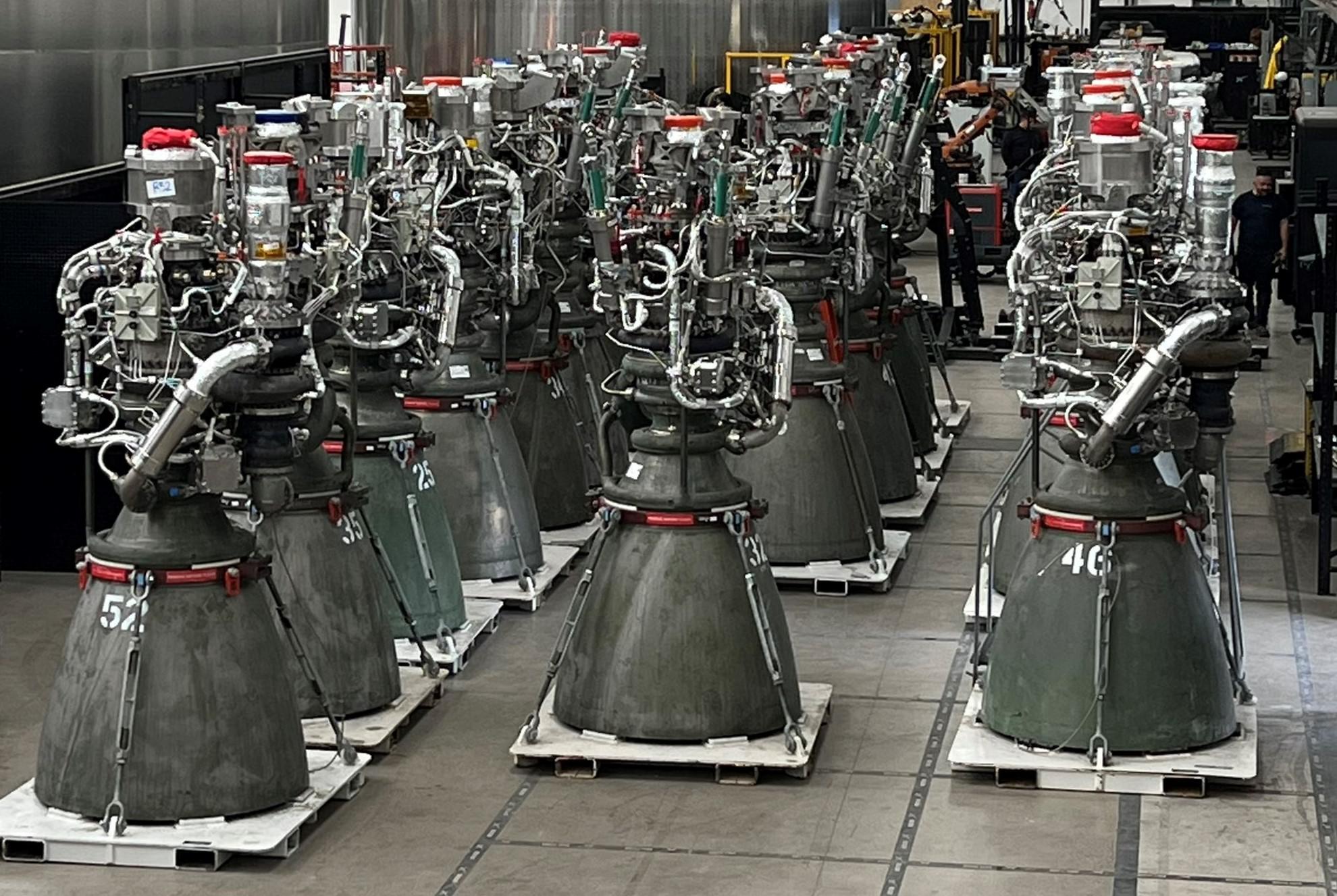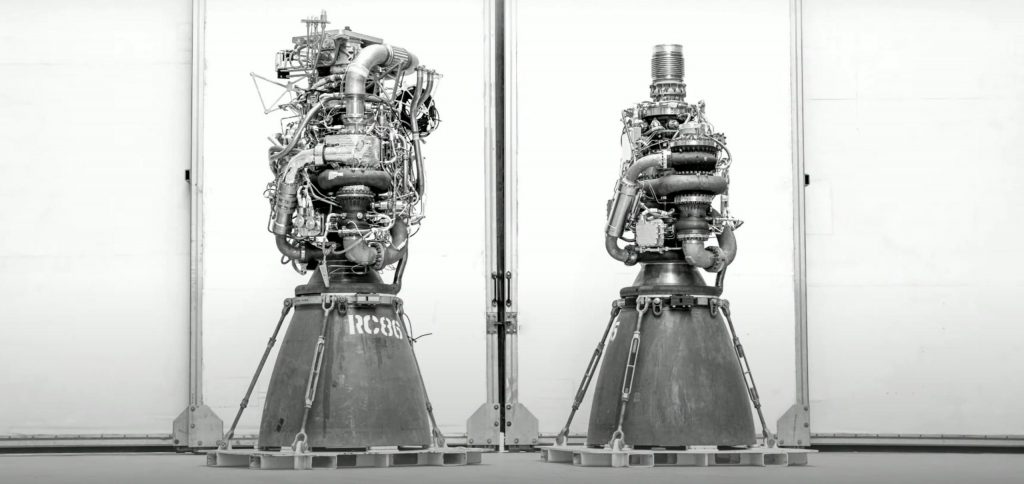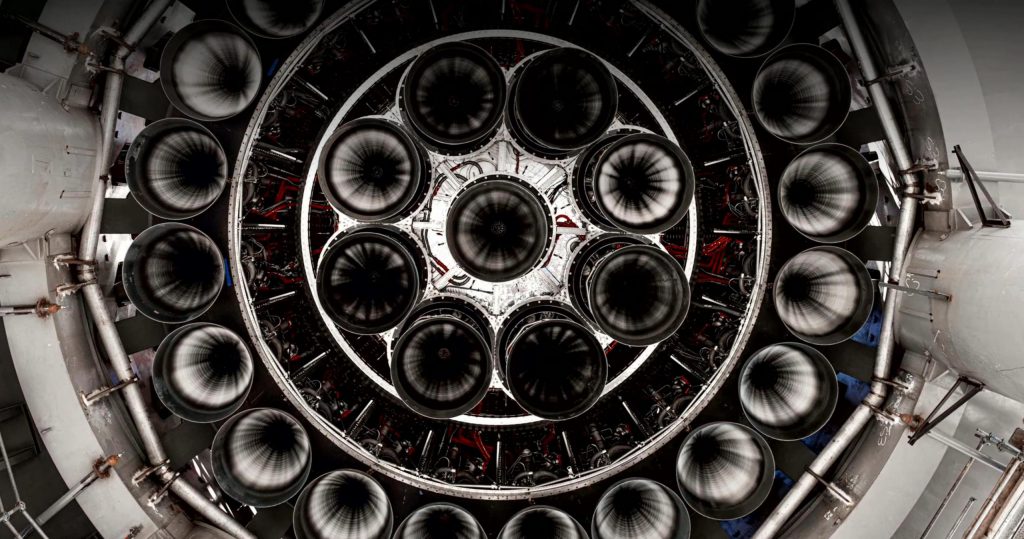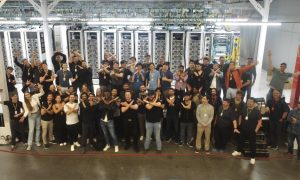

News
SpaceX rapidly shipping upgraded Raptor engines to Starbase
SpaceX appears to have opened the floodgates and begun shipping upgraded ‘Raptor V2’ engines to Starbase en masse in preparation for crucial Starship and Super Heavy testing.
The first functional Raptor engine delivery in around half a year and the first Raptor V2 delivery ever appeared to arrive at Starbase on March 30th. About a month and a half prior, SpaceX brought an early Raptor V2 prototype damaged during testing to serve as a backdrop for CEO Elon Musk’s February 10th Starship presentation, marking the first time the public was allowed to see or photograph the engine up close.
Less than three months later, Raptor V2 engines that passed proof testing without damaging or destroying themselves have begun to rapidly pile up inside one of Starbase’s three main production tents.
Though Raptor V2 has plenty in common with its Raptor V1 and V1.5 predecessors and, for the most part, looks very similar, Musk has repeatedly stated that the engine represents a major evolution from past Raptors. Most importantly, Raptor V2 was designed to significantly cut production cost and time. To achieve that, almost every major component was either fully redesigned, tweaked, or refined in some way to make Raptor simpler and more compact.
One example is the decision to slash the number of flanges (mechanical joints) in the engine’s plumbing by replacing them with welds. Making plumbing more monolithic could remove dozens of parts, seals, and potential leak points and significantly speed up manufacturing at the cost of making it harder – if not impossible – for SpaceX to inspect and replace certain pipes or pipe sections in a modular manner.

That process was repeated throughout each Raptor system, resulting in an engine that looks more streamlined than earlier variants. As a result of its more refined design and improvements to other critical components, Musk says that even though Raptor V2 now costs about half as much to build as V1.5, it’s also “much more…reliable.”
Despite significantly improving Raptor’s reliability, simplicity, and cost, SpaceX also managed to boost its maximum thrust by almost 25%. Raptor V2 engines now “routinely” operate at record-breaking main combustion chamber pressures of 300+ bar (~4400 psi) and are able to produce up to 230 tons (~510,000 lbf) of thrust at sea level. The older Raptor V1.5 engines that flew on Starships SN8-SN11 and SN15 and were installed on Super Heavy Booster 4 and Ship 20 were designed to produce around 185 tons (~410,000 lbf) at 250 bar (~3600 psi).
Following the premature retirement of Super Heavy Booster 4 (B4), which was meant to help send Starship S20 to space on the rocket’s first orbital launch attempt, that orbital launch debut is now guaranteed to use a different booster and ship powered by Raptor V2 engines. Ship 24 is a strong candidate for the mission’s Starship, while it remains to be seen if SpaceX will fully repair and attempt to proceed with Booster 7 or if Booster 8 – which is almost complete – will take point.
Either way, the pair will need at least 39 qualified Raptor V2 engines to begin integrated testing, pass several major static fire milestones, and prepare for flight. Since SpaceX appeared to kick off Raptor V2 deliveries to Starbase on March 30th, a photo shared by Musk on April 26th revealed that the company has managed to deliver at least 18 of the upgraded engines in the last four weeks. At least one more engine was also delivered on April 28th.

That means that SpaceX already has enough engines to begin static fire tests with a full cluster of 13 central Raptors on Super Heavy B7 or B8. By the time Ship 24 is fully assembled, Booster 7 is repaired, or Booster 8 is completed, there’s a good chance that SpaceX will have all the engines it needs to fully outfit a Starship and Super Heavy pair – not quite by the end of April, as Musk predicted, but not far off.
News
Tesla launches in India with Model Y, showing pricing will be biggest challenge
Tesla finally got its Model Y launched in India, but it will surely come at a price for consumers.

Tesla has officially launched in India following years of delays, as it brought its Model Y to the market for the first time on Tuesday.
However, the launch showed that pricing is going to be its biggest challenge. The all-electric Model Y is priced significantly higher than in other major markets in which Tesla operates.
On Tuesday, Tesla’s Model Y went up for sale for 59,89,000 rupees for the Rear-Wheel Drive configuration, while the Long Range Rear-Wheel Drive was priced at 67,89,000.
This equates to $69,686 for the RWD and $78,994 for the Long Range RWD, a substantial markup compared to what these cars sell for in the United States.
🚨 Here’s the difference in price for the Tesla Model Y in the U.S. compared to India.
🚨 59,89,000 is $69,686
🚨 67,89,000 is $78,994 pic.twitter.com/7EUzyWLcED— TESLARATI (@Teslarati) July 15, 2025
Deliveries are currently scheduled for the third quarter, and it will be interesting to see how many units they can sell in the market at this price point.
The price includes tariffs and additional fees that are applied by the Indian government, which has aimed to work with foreign automakers to come to terms on lower duties that increase vehicle cost.
Tesla Model Y seen testing under wraps in India ahead of launch
There is a chance that these duties will be removed, which would create a more stable and affordable pricing model for Tesla in the future. President Trump and Indian Prime Minister Narendra Modi continue to iron out those details.
Maharashtra Chief Minister Devendra Fadnavis said to reporters outside the company’s new outlet in the region (via Reuters):
“In the future, we wish to see R&D and manufacturing done in India, and I am sure at an appropriate stage, Tesla will think about it.”
It appears to be eerily similar to the same “game of chicken” Tesla played with Indian government officials for the past few years. Tesla has always wanted to enter India, but was unable to do so due to these import duties.
India wanted Tesla to commit to building a Gigafactory in the country, but Tesla wanted to test demand first.
It seems this could be that demand test, and the duties are going to have a significant impact on what demand will actually be.
Elon Musk
Tesla ups Robotaxi fare price to another comical figure with service area expansion
Tesla upped its fare price for a Robotaxi ride from $4.20 to, you guessed it, $6.90.

Tesla has upped its fare price for the Robotaxi platform in Austin for the first time since its launch on June 22. The increase came on the same day that Tesla expanded its Service Area for the Robotaxi ride-hailing service, offering rides to a broader portion of the city.
The price is up from $4.20, a figure that many Tesla fans will find amusing, considering CEO Elon Musk has used that number, as well as ’69,’ as a light-hearted attempt at comedy over the past several years.
Musk confirmed yesterday that Tesla would up the price per ride from that $4.20 point to $6.90. Are we really surprised that is what the company decided on, as the expansion of the Service Area also took effect on Monday?
But the price is now a princely $6.90, as foretold in the prophecy 😂
— Elon Musk (@elonmusk) July 14, 2025
The Service Area expansion was also somewhat of a joke too, especially considering the shape of the new region where the driverless service can travel.
I wrote yesterday about how it might be funny, but in reality, it is more of a message to competitors that Tesla can expand in Austin wherever it wants at any time.
Tesla’s Robotaxi expansion wasn’t a joke, it was a warning to competitors
It was only a matter of time before the Robotaxi platform would subject riders to a higher, flat fee for a ride. This is primarily due to two reasons: the size of the access program is increasing, and, more importantly, the service area is expanding in size.
Tesla has already surpassed Waymo in Austin in terms of its service area, which is roughly five square miles larger. Waymo launched driverless rides to the public back in March, while Tesla’s just became available to a small group in June. Tesla has already expanded it, allowing new members to hail a ride from a driverless Model Y nearly every day.
The Robotaxi app is also becoming more robust as Tesla is adding new features with updates. It has already been updated on two occasions, with the most recent improvements being rolled out yesterday.
Tesla updates Robotaxi app with several big changes, including wider service area
News
Tesla Model Y and Model 3 dominate U.S. EV sales despite headwinds
Tesla’s two mainstream vehicles accounted for more than 40% of all EVs sold in the United States in Q2 2025.

Tesla’s Model Y and Model 3 remained the top-selling electric vehicles in the U.S. during Q2 2025, even as the broader EV market dipped 6.3% year-over-year.
The Model Y logged 86,120 units sold, followed by the Model 3 at 48,803. This means that Tesla’s two mainstream vehicles accounted for 43% of all EVs sold in the United States during the second quarter, as per data from Cox Automotive.
Tesla leads amid tax credit uncertainty and a tough first half
Tesla’s performance in Q2 is notable given a series of hurdles earlier in the year. The company temporarily paused Model Y deliveries in Q1 as it transitioned to the production of the new Model Y, and its retail presence was hit by protests and vandalism tied to political backlash against CEO Elon Musk. The fallout carried into Q2, yet Tesla’s two mass-market vehicles still outsold the next eight EVs combined.
Q2 marked just the third-ever YoY decline in quarterly EV sales, totaling 310,839 units. Electric vehicle sales, however, were still up 4.9% from Q1 and reached a record 607,089 units in the first half of 2025. Analysts also expect a surge in Q3 as buyers rush to qualify for federal EV tax credits before they expire on October 1, Cox Automotive noted in a post.
Legacy rivals gain ground, but Tesla holds its commanding lead
General Motors more than doubled its EV volume in the first half of 2025, selling over 78,000 units and boosting its EV market share to 12.9%. Chevrolet became the second-best-selling EV brand, pushing GM past Ford and Hyundai. Tesla, however, still retained a commanding 44.7% electric vehicle market share despite a 12% drop in in Q2 revenue, following a decline of almost 9% in Q1.
Incentives reached record highs in Q2, averaging 14.8% of transaction prices, roughly $8,500 per vehicle. As government support winds down, the used EV market is also gaining momentum, with over 100,000 used EVs sold in Q2.
Q2 2025 Kelley Blue Book EV Sales Report by Simon Alvarez on Scribd
-

 News3 days ago
News3 days agoTesla debuts hands-free Grok AI with update 2025.26: What you need to know
-

 Elon Musk1 week ago
Elon Musk1 week agoElon Musk confirms Grok 4 launch on July 9 with livestream event
-

 Elon Musk5 days ago
Elon Musk5 days agoxAI launches Grok 4 with new $300/month SuperGrok Heavy subscription
-

 News2 weeks ago
News2 weeks agoTesla Model 3 ranks as the safest new car in Europe for 2025, per Euro NCAP tests
-

 Elon Musk2 weeks ago
Elon Musk2 weeks agoxAI’s Memphis data center receives air permit despite community criticism
-

 News5 days ago
News5 days agoTesla begins Robotaxi certification push in Arizona: report
-

 Elon Musk2 weeks ago
Elon Musk2 weeks agoTesla reveals it is using AI to make factories more sustainable: here’s how
-

 Elon Musk2 weeks ago
Elon Musk2 weeks agoTesla scrambles after Musk sidekick exit, CEO takes over sales
















